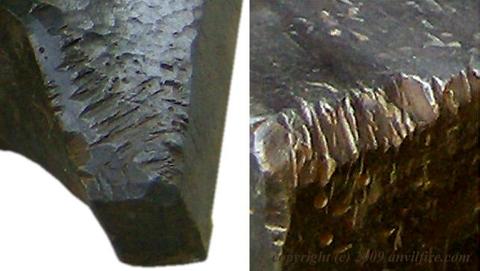This beauty is one of the standard North German anvil patterns that have been copied by many later makers.
This anvil has clean graceful lines and perfect symmetry.
The waist gives it good lines but is not too narrow. The heavy base gives it stability.

This is the same style anvil detailed in the drawing shown in this PDF
CAD Drawing by Jock Dempsey of a 450 pound version in Josh Greenwood's shop.
- Dimensions: 733 pounds (333 kg)
- Height 17" x Width 7-1/4" x Length 44-1/2" (432 x 184 x 1130 mm)
- Base: Width 14-1/2" x Length 19" (368 x 483 mm)
- Dimensions: 450 pounds (204 kg)
- Height 14.38" x Weight 6.62" x Length 36.87" (365 x 168 x 937 mm)
- Base: Width 12-1/2" x Length 17-3/8" (318 x 442 mm)

Chisel Cutting
the edges of anvils was a traditional method of testing the hardening and tempering of chisels in the first half of the 20th century.
The base of a wrought body anvil is soft so the test was harmless to a well hardened and tempered tool.
This was a type of proof testing but it is unknown if it was done for the customer or the smith.





 Return to The Lyda-Ferdinand Collection
Return to The Lyda-Ferdinand Collection Anvil Collections Gallery Index
Anvil Collections Gallery Index